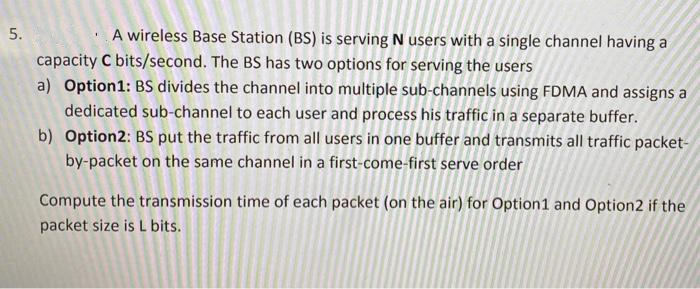5. A wireless Base Station (BS) is serving N users with a single channel having a capacity C bits/second. The BS has two options for serving the users a) Option1: BS divides the channel into multiple sub-channels using FDMA and assigns a dedicated sub-channel to each user and process his traffic in a separate buffer. b) Option2: BS put the traffic from all users in one buffer and transmits all traffic packet- by-packet on the same channel in a first-come-first serve order Compute the transmission time of each packet (on the air) for Option1 and Option2 if the packet size is L bits.
5. A wireless Base Station (BS) is serving N users with a single channel having a capacity C bits/second. The BS has two options for serving the users a) Option1: BS divides the channel into multiple sub-channels using FDMA and assigns a dedicated sub-channel to each user and process his traffic in a separate buffer. b) Option2: BS put the traffic from all users in one buffer and transmits all traffic packet- by-packet on the same channel in a first-come-first serve order Compute the transmission time of each packet (on the air) for Option1 and Option2 if the packet size is L bits.
Computer Networking: A Top-Down Approach (7th Edition)
7th Edition
ISBN:9780133594140
Author:James Kurose, Keith Ross
Publisher:James Kurose, Keith Ross
Chapter1: Computer Networks And The Internet
Section: Chapter Questions
Problem R1RQ: What is the difference between a host and an end system? List several different types of end...
Related questions
Question

Transcribed Image Text:5.
A wireless Base Station (BS) is serving N users with a single channel having a
capacity C bits/second. The BS has two options for serving the users
a) Option1: BS divides the channel into multiple sub-channels using FDMA and assigns a
dedicated sub-channel to each user and process his traffic in a separate buffer.
b) Option2: BS put the traffic from all users in one buffer and transmits all traffic packet-
by-packet on the same channel in a first-come-first serve order
1
Compute the transmission time of each packet (on the air) for Option1 and Option2 if the
packet size is L bits.
Expert Solution
This question has been solved!
Explore an expertly crafted, step-by-step solution for a thorough understanding of key concepts.
Step by step
Solved in 3 steps

Recommended textbooks for you

Computer Networking: A Top-Down Approach (7th Edi…
Computer Engineering
ISBN:
9780133594140
Author:
James Kurose, Keith Ross
Publisher:
PEARSON

Computer Organization and Design MIPS Edition, Fi…
Computer Engineering
ISBN:
9780124077263
Author:
David A. Patterson, John L. Hennessy
Publisher:
Elsevier Science

Network+ Guide to Networks (MindTap Course List)
Computer Engineering
ISBN:
9781337569330
Author:
Jill West, Tamara Dean, Jean Andrews
Publisher:
Cengage Learning

Computer Networking: A Top-Down Approach (7th Edi…
Computer Engineering
ISBN:
9780133594140
Author:
James Kurose, Keith Ross
Publisher:
PEARSON

Computer Organization and Design MIPS Edition, Fi…
Computer Engineering
ISBN:
9780124077263
Author:
David A. Patterson, John L. Hennessy
Publisher:
Elsevier Science

Network+ Guide to Networks (MindTap Course List)
Computer Engineering
ISBN:
9781337569330
Author:
Jill West, Tamara Dean, Jean Andrews
Publisher:
Cengage Learning

Concepts of Database Management
Computer Engineering
ISBN:
9781337093422
Author:
Joy L. Starks, Philip J. Pratt, Mary Z. Last
Publisher:
Cengage Learning

Prelude to Programming
Computer Engineering
ISBN:
9780133750423
Author:
VENIT, Stewart
Publisher:
Pearson Education

Sc Business Data Communications and Networking, T…
Computer Engineering
ISBN:
9781119368830
Author:
FITZGERALD
Publisher:
WILEY